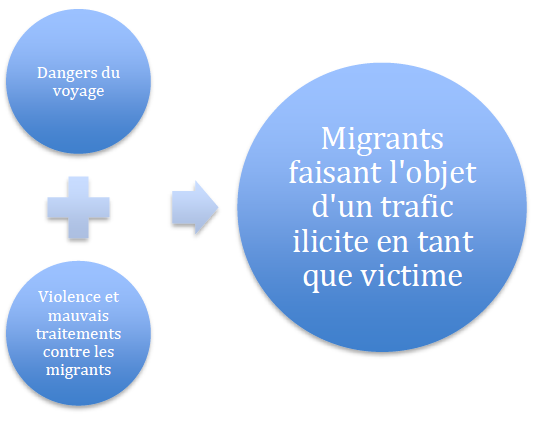Publié en janvier 2019
Ce module est une ressource pour les enseignants
L'étendue de la protection
La CTOC et le Protocole contre le trafic illicite de migrants sont des instruments de justice pénale. La réglementation internationale du crime de trafic illicite de migrants a été déclenchée par la nécessité de lutter contre les groupes criminels organisés opérant à l'échelle transnationale et présentant de graves risques pour la sécurité nationale et l'ordre public (Gallagher, 2001). Les raisons qui ont motivé la création du Protocole, en particulier les préoccupations des États au sujet de ceux qui entrent illégalement sur leur territoire, informent de l'objectif d'incrimination du trafic illicite de migrants. Il est important de noter que le Protocole ne considère pas les migrants faisant l'objet de trafic illicite comme des "victimes" et que cette terminologie n'est pas utilisée.
Quoi qu'il en soit, le Protocole contre le trafic illicite de migrants reconnaît que les migrants faisant l'objet d'un trafic illicite méritent d'être protégés. Les dispositions des articles 9 et 16 portent sur le traitement humain et la protection des migrants faisant l'objet d'un trafic illicite, tandis que l'article 19 prévoit l'application du droit des réfugiés, de droit humanitaire et des droits humains. En outre, les infractions aggravées visées à l'article 6 reconnaissent que les peines devraient être augmentées lorsque la sécurité et la dignité des migrants faisant l'objet d'un trafic illicite sont affectées. Il convient de noter qu'en réalité, le trafic illicite de migrants a entraîné la mort de milliers d'entre eux.
Le Préambule du Protocole contre la traite illicite des migrants détermine qu'il "faut traiter les migrants avec humanité et protéger pleinement leurs droits".
La protection des droits des migrants faisant l'objet d'un trafic illicite est l'un des objectifs du Protocole, outre la prévention et la répression du trafic illicite de migrants et la promotion de la coopération internationale. De même, l'article 4 du Protocole inclut la protection des droits des personnes qui ont fait l'objet de trafic illicite dans le champ d'application du Protocole. Ainsi, le champ d'application du Protocole contre le Trafic illicite de migrants s'étend au-delà de la prévention, des enquêtes et des poursuites en matière d'infractions liées au trafic illicite de migrants. Comme l'explique le Guide législatif pour l'application du Protocole contre le trafic illicite de migrants par Terre, mer et air, additionnel à la Convention des Nations Unies contre la Criminalité Transnationale Organisée, puisque les "biens" faisant l'objet du trafic sont les personnes, le trafic illicite de migrants soulève des problèmes au niveau des droits de l'homme et d'autres questions non liées à d'autres marchandises, comme les armes et les stupéfiants, sur lesquels la CTOC se concentre également" (paragraphe 55). Les droits et protections dus aux migrants faisant l'objet d'un trafic illicite sont exposés plus en détail dans le Module 2.
Encadré 20
Les migrants faisant l'objet d'un trafic illicite ne sont pas des victimes - mise en gardeMalgré les concepts expliqués ci-dessus, il convient de noter que si le Protocole contre le trafic illicite de migrants ne reconnaît pas les migrants faisant l'objet d'un trafic illicite comme victimes du trafic illicite de migrants, cela ne revient pas à affirmer que les migrants faisant l'objet d'un trafic illicite ne sont pas des victimes en termes absolus. Une personne peut être victime d'autres crimes, y compris de violations des droits de l'homme, au cours du processus trafic illicite, par exemple :
|
Il est important de noter que les dangers auxquels les migrants sont couramment exposés - généralement en raison de méthodes de trafic illicite risquées visant à échapper aux autorités et à maximiser les profits - peuvent, dans certaines circonstances, faire des migrants faisant l'objet de trafic illicite des victimes de la criminalité.
Figure 2 : Migrants faisant l'objet d'un trafic illicite en tant que victimes de la criminalité

La figure 2 identifie deux facteurs qui ont conduit à une reconnaissance progressive, dans certaines circonstances, des migrants faisant l'objet d'un trafic illicite comme victimes de la criminalité. D'une part, les dangers souvent graves liés à la vie, la sécurité et l'intégrité physique des migrants lors d'opérations de trafic illicites et, d'autre part, les violences et mauvais traitements auxquels ces migrants sont souvent soumis.
 Section suivante: Exemption humanitaire
Section suivante: Exemption humanitaire
 Haut de page
Haut de page